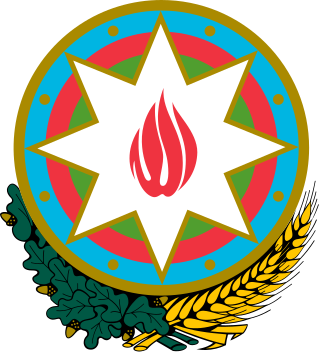
Stepanakert, or Khankendi, is the de facto capital and the largest city of the breakaway Republic of Artsakh, de jure part of Azerbaijan, located within the disputed region of Nagorno-Karabakh. The city is located in a valley on the eastern slopes of the Karabakh mountain range, on the left bank of the Karkar river.

Artsakh, officially the Republic of Artsakh or the Nagorno-Karabakh Republic, is a doubly landlocked breakaway state in the South Caucasus whose territory is internationally recognised as part of Azerbaijan. Artsakh controls a part of the former Nagorno-Karabakh Autonomous Oblast, including the capital of Stepanakert. It is an enclave within Azerbaijan. Its only overland access route to Armenia is via the 5 km (3.1 mi) wide Lachin corridor which is under the control of Russian peacekeepers.

Politics of Artsakh takes place within the constraints of a written constitution, approved by a popular vote, that recognises three branches of government: executive, legislative and judicial. The executive branch of government is exercised within a framework of a presidential representative democratic republic, whereby the President of Artsakh is both the head of state and the head of government. The legislative branch of government is composed of both the Government and the National Assembly. Elections to the National Assembly are on the basis of a multi-party system. As of 2009, the American-based non-governmental organisation, Freedom House, ranks Artsakh above both Armenia and Azerbaijan in terms of political and civil rights. The republic is de facto independent and de jure a part of Azerbaijan. None of the elections in Artsakh are recognised by international bodies such as the OSCE Minsk Group, the European Union or the Organisation of Islamic Cooperation. Both Azerbaijan and Turkey have condemned the elections and called them a source of increased tensions.

Shahumyan Province is a claimed province of the breakaway Republic of Artsakh, de jure part of the Republic of Azerbaijan. The capital of the province was Karvachar. Shahumyan Province had 17 communities of which one is considered urban and 16 are rural. Its bordered Martakert Province to the east, Kashatagh Province to the south, Gegharkunik and Vayots Dzor provinces of Armenia to the west and Dashkasan, Goygol and Goranboy districts of Azerbaijan to the north.

The Republic of Artsakh is a republic with limited recognition in the South Caucasus region. The Republic of Artsakh controls most of the territory of the former Nagorno-Karabakh Autonomous Oblast. It is recognized only by three other non-UN member states, Abkhazia, South Ossetia and Transnistria. The rest of the international community recognizes Artsakh as part of Azerbaijan. In November 2012, a member of Uruguay's foreign relations committee stated that his country could recognize Nagorno-Karabakh's independence. In 2012, Armenia and Tuvalu established diplomatic relations and it was expected that Tuvalu may recognize Artsakh's independence. In October 2012, the Australian state of New South Wales recognized Nagorno-Karabakh. In September 2014, the Basque Parliament in Spain adopted a motion supporting Artsakh's right to self-determination and in November 2014, the Parliament of Navarre, also in Spain, issued a statement supporting Artsakh's inclusion in taking part in settlement negotiations.

The administrative divisions of the Republic of Artsakh are of two types; provinces and cities. There are six provinces and one special administrative city - the capital of the Republic.
Ganja International Airport is an airport serving Ganja, the second-largest city in Azerbaijan.
Artsakh, officially the Republic of Artsakh, also known as the Nagorno-Karabakh Republic, is a de facto breakaway state in the South Caucasus currently populated by Armenians, but de jure considered a part of Azerbaijan.

The following outline is provided as an overview and topical guide of the Republic of Artsakh and Nagorno-Karabakh region:

Khojaly or Ivanyan is a town de facto in the Askeran Province of the breakaway Republic of Artsakh, de jure in the Khojaly District of Azerbaijan, in the disputed region of Nagorno-Karabakh. Stepanakert Airport is located to the immediate south of the town.
This page list topics related to the Republic of Artsakh and Nagorno-Karabakh region.

Stepanakert Airport, referred to as the Khojaly Airport in Azerbaijan, is an airport in the town of Ivanyan (Khojaly), 10 kilometers north-east of Stepanakert, the regional capital of the de facto Republic of Artsakh, de jure part of Azerbaijan. The airport, in the disputed Nagorno-Karabakh region, has been under the control of the republic since 1992. Flights ceased with the escalation of the First Nagorno-Karabakh War in 1990.

Visitors to Azerbaijan must obtain a visa from one of the Azerbaijani diplomatic missions unless they come from one of the visa-exempt countries, countries eligible for visas on arrival or countries eligible for electronic visas. Visitors must hold passports that are valid for at least 3 months beyond the intended period of stay.

The political status of Nagorno-Karabakh has remained unresolved since its declaration of independence from the Soviet Union enacted on 10 December, 1991. During the Soviet Union, it had been an ethnic Armenian autonomous oblast of the Azerbaijan Soviet Socialist Republic. Following the disintegration of the USSR, a conflict arose between local Armenians who sought to join Nagorno-Karabakh to Armenia, and local Azerbaijanis who opposed this.

Visitors to Artsakh must obtain a visa unless they come from one of the visa exempt countries.

The blockade of Artsakh is an ongoing event in the Nagorno-Karabakh conflict. The region is disputed between Azerbaijan and the breakaway Republic of Artsakh, which has an ethnic Armenian population and is supported by neighbouring Armenia. Since 2020, Russian peacekeepers have been deployed to the region under a ceasefire agreement.









